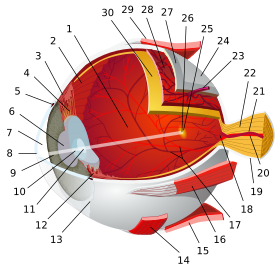طبقة دوا
طبقة دوا Dua's layer، هي طبقة مكتشفة حديثاُ في قرنية الإنسان، طُرحت في مقالة علمية في يونيو 2013.[1] يبلغ سمكها 15 micrometres (0.00059 inches) وهي رابعة طبقة من الأمام، وتقع بين سدى القرنية وDescemet's membrane. وهي سادس طبقة يتم اكتشافها في القرنية[2][3] بالرغم من سماكتها الصغيرة، إلى أنها شديدة القوة وتتمتع بمقاومة عالية للهواء.[1]وهي قوية بما يكفي بتحمل 2 bars (200 kPa) من الضغط.[4]
. . . . . . . . . . . . . . . . . . . . . . . . . . . . . . . . . . . . . . . . . . . . . . . . . . . . . . . . . . . . . . . . . . . . . . . . . . . . . . . . . . . . . . . . . . . . . . . . . . . . . . . . . . . . . . . . . . . . . . . . . . . . . . . . . . . . . . . . . . . . . . . . . . . . . . . . . . . . . . . . . . . . . . . .
الاكتشاف
نشرت ورقة بحثية في 2013، كتبها هارميندر سينغ دوا، تحدث فيها عن وجود طبقة دوا.[4] كان فريق دوا في جامعة نوتنگهام يقوم بأبحاث تتعلق بزراعة العيون من المتبرعين. Simulating corneal surgery, they injected tiny bubbles of air into the cornea. Descemet's membrane was surgically removed, causing the air bubble to dissipate in some specimens ("type II bubbles"), but not others ("type I bubbles"). Further experimentation revealed that all air-bubble-free specimens could be re-inflated with a type I bubble. After the bubble was inflated to the point of popping, no further bubble could be formed from further injection, indicating that the bubble was being trapped by a distinct layer of material, not a random variation in the corneal stroma.[1]
The experimental results were confirmed by electron microscopy. The microscope showed a thin layer of corneal collagen between the corneal stroma and Descemet's membrane.[1] The find was described in medical journal Ophthalmology in May 2013.[1] The previously unknown layer was named for the team leader, professor Harminder Dua, who said the discovery means "ophthalmology textbooks will literally need to be re-written."[4]
تأثيرات الاكتشاف
The authors of the paper on the discovery believe that it may have important medical implications. Dua's layer may help surgeons improve outcomes for patients undergoing corneal grafts and transplants. During surgery, tiny air bubbles are injected into the corneal stroma in what is known as the "big bubble technique". Sometimes the bubble bursts, damaging the patient's eye.[1] If the air bubble is injected under Dua's layer instead of above it, the layer's strength could reduce the risk of tearing.[1][5]
The understanding of diseases of the cornea, including acute hydrops, descemetocele, and pre-Descemet's dystrophies, may be affected by the discovery of Dua's layer. "From a clinical perspective, there are many diseases that affect the back of the cornea, which clinicians across the world are already beginning to relate to the presence, absence, or tear in this layer," Dua stated.[4]
Corneal hydrops, a buildup of fluid in the cornea that is common in patients with keratoconus (a conical deformity of the cornea) might be caused by a tear in Dua's layer.[4] Dua hypothesizes that such a tear would allow water from inside the eye to pass through and cause fluid buildup.[3]
المصادر
- ^ أ ب ت ث ج ح خ DOI:10.1016/j.ophtha.2013.01.018
This citation will be automatically completed in the next few minutes. You can jump the queue or expand by hand - ^ Olson, Samantha (13 June 2013). "New Cornea Layer Discovered In Human Eye: Doctors Predict Safer And Simpler Eye Treatments". Medical Daily. Retrieved 14 June 2013.
- ^ أ ب "New Layer Of Human Eye,'Dua's Layer,' Discovered Behind Cornea". Huffington Post Live Science. June 12, 2013. Retrieved June 13, 2013.
- ^ أ ب ت ث ج Kristin Butler (June 12, 2013). "Scientists discover new layer of human cornea". UPI. Retrieved June 12, 2013.قالب:Medrs
- ^ "Scientists discover new layer of the human cornea" (Press release). University of Nottingham. June 12, 2013. Retrieved 11 June 2013.


